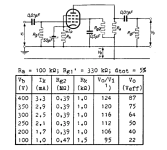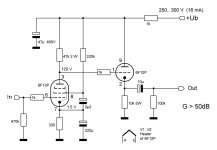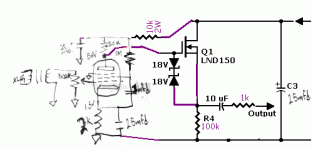Hello all. New here but not to building tube amplifiers(Have generall built my own guitar amps and use them live, however I'm not a technician
Right now I'm building some microphone preamps based upon the Rod Childers 2-1 Boris Akai /ROberts Conversion. This takes the modular units from an old Roberts/Akai reel to reel and converts them into a pair of transformer balanced microphone preamps using shure m67 input transformers.
I'm building these for my friend's low fi home studio. He is recording straight to an old multi track tape machine and wants some funky coloured pres for character.
However the EF86 preamp doesn't seem to be providing enough gain.
It's transformer balanced in and an unbalanced output
It was suggested elsewhere that the problem was likely impedance and that a follower would help.
I had a couple of suggestions ,one was based on an LND150 and somebody else suggested the IRF820
Solid state was suggested due to lack of room and ease of implementation.
I as curious which would be better in this application? or if it really matters
Also any suggestions as to the best circuit to use?
Here is a rough hand drawn schematic of the EF 86 Preamp
Thanks
Right now I'm building some microphone preamps based upon the Rod Childers 2-1 Boris Akai /ROberts Conversion. This takes the modular units from an old Roberts/Akai reel to reel and converts them into a pair of transformer balanced microphone preamps using shure m67 input transformers.
I'm building these for my friend's low fi home studio. He is recording straight to an old multi track tape machine and wants some funky coloured pres for character.
However the EF86 preamp doesn't seem to be providing enough gain.
It's transformer balanced in and an unbalanced output
It was suggested elsewhere that the problem was likely impedance and that a follower would help.
I had a couple of suggestions ,one was based on an LND150 and somebody else suggested the IRF820
Solid state was suggested due to lack of room and ease of implementation.
I as curious which would be better in this application? or if it really matters
Also any suggestions as to the best circuit to use?
Here is a rough hand drawn schematic of the EF 86 Preamp
Thanks
Attachments
How much gain do you need from the pentode stage?However the EF86 preamp doesn't seem to be providing enough gain.
What is the load impedance of the (whole) preamplifier?
Yep probably needs a follower the output impedance will be very high. What about a tube follower 12AU7 or ECC88. You could use both halves in parallel.
On one of the pres I do have space for a new tube socket a couple of sockets away from the EF86 on the other I'd have to move a socket(desoldering. moving the heaters etc. etc.) However there isn't much space on the lug board, in fact very little to almost none.
Also the heater current draw and likely voltage loss to the other stages. I do have plenty of 12au7s but the budget is low so something that doesn't require a lot of rewiring, adding tube sockets etc. would be ideal.
So, many reasons not to add another tube in this instance
Also the heater current draw and likely voltage loss to the other stages. I do have plenty of 12au7s but the budget is low so something that doesn't require a lot of rewiring, adding tube sockets etc. would be ideal.
So, many reasons not to add another tube in this instance
Weird, pentodes have TONS of gain.However the EF86 preamp doesn't seem to be providing enough gain.
Easily 200X
WHAT are you trying to drive?It's transformer balanced in and an unbalanced output
It was suggested elsewhere that the problem was likely impedance and that a follower would help.
Suspect horrible impedance matching.
Yes, a cathode follower might help, but we need to know your load first.
So the fellow I'm building them for was running them into two things with lackluster gain results
ONe was a DDA console with I believe 2k mic inputs and 10k line inputs. I believe he was using the line inputs
He was also trying an Orion antelope 32 that I believe has 11.2k inputs
Was checking manuals online for both of them.
THe valve wizard seems to suggest with my schematic I could be seeing 250k output impedance. The shure m67 units use one of the same tranformers they use for input in reverse for their balanced output, which is 600ohms. COuld I just use one of these. I think there 10-1, maybe i'd still have a 25k output . I'm probably looking for closer to 600 ohms yes?
Excuse my ignorance, whilst I have been succesful with building amps, it's more like lego for me and my theory is pretty thin
ONe was a DDA console with I believe 2k mic inputs and 10k line inputs. I believe he was using the line inputs
He was also trying an Orion antelope 32 that I believe has 11.2k inputs
Was checking manuals online for both of them.
THe valve wizard seems to suggest with my schematic I could be seeing 250k output impedance. The shure m67 units use one of the same tranformers they use for input in reverse for their balanced output, which is 600ohms. COuld I just use one of these. I think there 10-1, maybe i'd still have a 25k output . I'm probably looking for closer to 600 ohms yes?
Excuse my ignorance, whilst I have been succesful with building amps, it's more like lego for me and my theory is pretty thin
Last edited:
Impedance goes with the square of the turns ratio, so you would end up with 2.5 kohm output impedance - assuming the transformer is close enough to ideal, that is.
Sorry, further research(sombody elses) would suggest the shure M67 transformers are a 14/15 - 1 ratio
So I guess more like 1.2-1.1 K
Can I tweak my plate resistor and cathode setup to get this to be more like 5-600 ohms with the above transformer Maybe with a 100K plate resistor and a 1k cathode resistor, something like this philips datasheet(whole circuit would be tweaked).
And would I have to use a balanced output for this?
(still interested in the LND150 buffer too just checking out possibilities) Might try both options to see which I prefer if possible
So I guess more like 1.2-1.1 K
Can I tweak my plate resistor and cathode setup to get this to be more like 5-600 ohms with the above transformer Maybe with a 100K plate resistor and a 1k cathode resistor, something like this philips datasheet(whole circuit would be tweaked).
And would I have to use a balanced output for this?
(still interested in the LND150 buffer too just checking out possibilities) Might try both options to see which I prefer if possible
Attachments
10K load is too low and would kill the gain of the stage , it's Rg1' in that schematic , you need a cathode follower as output buffer .
And for higher gain Ra should be as high as possible , 100K is the lowest value , you can go up to 470K or more with high enough B+
Balanced output or output transformer only if you use long cables , for home studio you don't need .
And for higher gain Ra should be as high as possible , 100K is the lowest value , you can go up to 470K or more with high enough B+
Balanced output or output transformer only if you use long cables , for home studio you don't need .
Last edited:
Remove/forget EF86 and replace it with a triode-pentode. Then you manage with existing 9-pin tube socket and do not need to add any semiconductors.So, many reasons not to add another tube in this instance...
Attached is one example that can drive 1k load with low THD, has low output impedance and more than 50 dB gain (>300x).
There are several alternatives for the triode-pentode such as 6BL8 etc.
However this 6F12P is superior since it has high gain and high gm too.
Attachments
Thanks, undoubtedly a good idea but it would be more cost outlay and time too. Looking around I could get a pair of what look liked used 6F12P off of Amazon.ca for about $20 Can (they would arrive maybe by the end of this month or into the next, and then I buy all the components for the new circuit and nuke and pave the old. Before I consider this route(and I am appreciate of the advice and schematic) is it something you've tried yourself in a microphone preamp?Remove/forget EF86 and replace it with a triode-pentode. Then you manage with existing 9-pin tube socket and do not need to add any semiconductors.
Attached is one example that can drive 1k load with low THD, has low output impedance and more than 50 dB gain (>300x).
There are several alternatives for the triode-pentode such as 6BL8 etc.
However this 6F12P is superior since it has high gain and high gm too.
The console is solid state anyway , you can use a transistor output buffer like this http://www.geofex.com/Article_Folders/mosfet_folly/mosfetfolly.htm
Should work the same for a pentode first stage
Should work the same for a pentode first stage
I think that Russian tube is cool, I was researching it a little. I'm curious about shipping put of the Ukraine and Russia right now, what have other peoples experiences been? The people I'm building these for aren't tube purists per se, they're making their own lowfi studio with a large variety of older gear. Having a solid state follower behind the pentode won't bother them at all.
A fellow from Hoffmans amplifiers nicely suggested this schematic...and then I was banned because my old email address was defunct(since straightened out) My electrical engineer brother in law said it looked okay but suggested I might want to put my DC blocking cap back in.
A fellow from Hoffmans amplifiers nicely suggested this schematic...and then I was banned because my old email address was defunct(since straightened out) My electrical engineer brother in law said it looked okay but suggested I might want to put my DC blocking cap back in.
Attachments
Direct coupling is OK , in this way the transistor is "autobiased" , the circuit is simpler and probably better sounding ...
Tubes from Ukraine would arrive almost normally .
Tubes from Ukraine would arrive almost normally .
The original design appears really compromised - the pentode is being strangled, with insufficient plate voltage and a 1M resistor on the screen, which will severely constrain the screen voltage for any reasonable value of screen current. This may explain the lack of gain in the circuit. If you look at the data sheet (readily available on the web) you get a range of component values and operating B+ voltage that will give you all the gain you need. Adding an LND150 follower (one fet as follower, one as current source load) will help to drive lower impedances. The IRF820 has too much gate capacitance to be really useful. Make sure to include a stopper resistor in series with the follower gate to prevent oscillation and some back-to-back zener diodes for gate protection.
The datasheet I cite is available here:
https://tube-data.com/sheets/010/e/EF86.pdf
The datasheet I cite is available here:
https://tube-data.com/sheets/010/e/EF86.pdf
Mismatch is extreme, not even the LND150 source follower can help you here.
Impedance may be low, purely because of high built in 100% NFB, and that applies at small signal conditions, but truth is that we have a 100k resistor trying to drive 2k or 10k class loads.
FET will source any current needed but to sink, the elephant in the room is the 100k resistor connected to ground.
**** poor performance.
I would bite the bullet and:
1) let pentode have as much gain as it can: I guess the idea is to color sound, it will do that better the higher signal swings at its plate.
2) now that you have the sound you want, attenuate output with a voltage divider (you do not need 80-90V RMS do you?), say 10:1 or 20:1, say 1M:100k or 1M:47k , the attenuator lower leg may vary well be an Audio potentiometer, call it Master Volume if you wish, and then drive a unity gain buffer, say a source follower with 4k7 to ground or even a very flat (it won't affect the pentode sound you just got) unity gain Op Amp.
Since you will not need 90V RMS you can use almost "any" FET fed from, say, +25V or so, or an Op Amp fed classic +/-15V
It will drive anything.
Impedance may be low, purely because of high built in 100% NFB, and that applies at small signal conditions, but truth is that we have a 100k resistor trying to drive 2k or 10k class loads.
FET will source any current needed but to sink, the elephant in the room is the 100k resistor connected to ground.
**** poor performance.
I would bite the bullet and:
1) let pentode have as much gain as it can: I guess the idea is to color sound, it will do that better the higher signal swings at its plate.
2) now that you have the sound you want, attenuate output with a voltage divider (you do not need 80-90V RMS do you?), say 10:1 or 20:1, say 1M:100k or 1M:47k , the attenuator lower leg may vary well be an Audio potentiometer, call it Master Volume if you wish, and then drive a unity gain buffer, say a source follower with 4k7 to ground or even a very flat (it won't affect the pentode sound you just got) unity gain Op Amp.
Since you will not need 90V RMS you can use almost "any" FET fed from, say, +25V or so, or an Op Amp fed classic +/-15V
It will drive anything.
I appreciate the input but I'm a little confused. I don't have a 100k resistor to ground in my current setup, that's the suggestion for the LND150 follower circuit. MY current circuit is the hand drawn circuit several posts previous to that one.
As far as the pentode gain goes. All the really high gain amps that use ef86 have big plate resistors while wrenchone is saying I should follow he numbers in the datasheet..which I was wondering too. Sadly JMFahey, I can't quite follow your suggestions due to my limited electronics knowledge. I was told the high voltage LND150 would work well as a follower after the pentode to buffer the impedance. The circuit withe the LND150 and the 100K resistor added was a suggestion
As far as the pentode gain goes. All the really high gain amps that use ef86 have big plate resistors while wrenchone is saying I should follow he numbers in the datasheet..which I was wondering too. Sadly JMFahey, I can't quite follow your suggestions due to my limited electronics knowledge. I was told the high voltage LND150 would work well as a follower after the pentode to buffer the impedance. The circuit withe the LND150 and the 100K resistor added was a suggestion
Last edited:
- Home
- Amplifiers
- Tubes / Valves
- EF86 Microphone preamp with solid state follower



